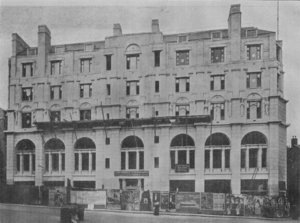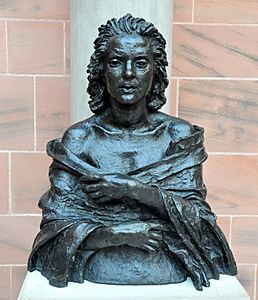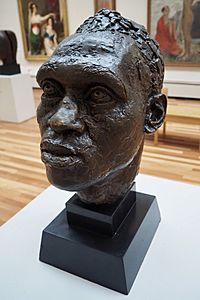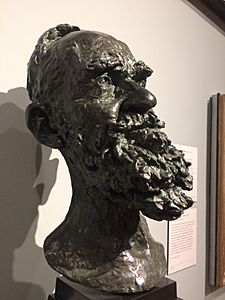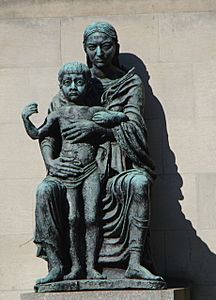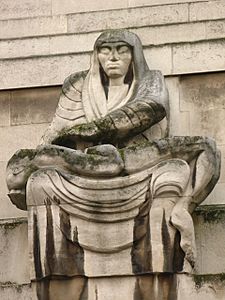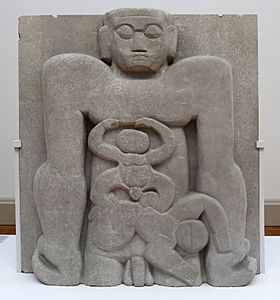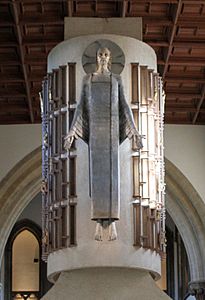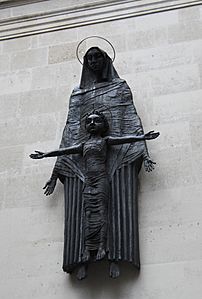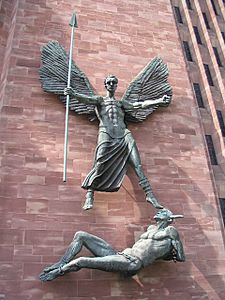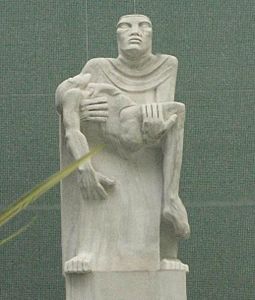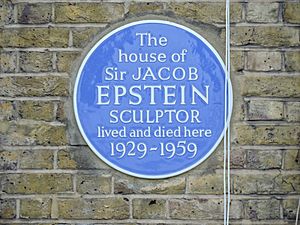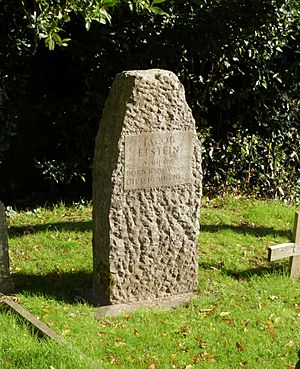Jacob Epstein facts for kids
Quick facts for kids
Jacob Epstein
|
|
|---|---|
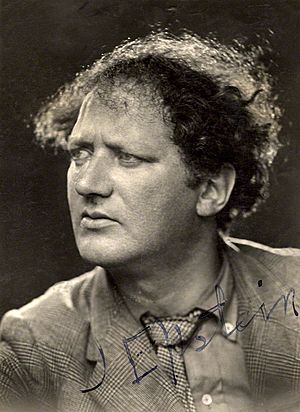
Jacob Epstein, photographed in 1921 by George Charles Beresford
|
|
| Born | 10 November 1880 New York City, U.S.
|
| Died | 21 August 1959 (aged 78) Hyde Park Gate, London, England
|
| Nationality | British / United States |
| Alma mater |
|
| Known for | Sculpture |
| Spouse(s) |
|
Sir Jacob Epstein KBE (10 November 1880 – 21 August 1959) was an American-British sculptor who helped pioneer modern sculpture. He was born in the United States, and moved to Europe in 1902, becoming a British subject in 1910.
Contents
Early life and education
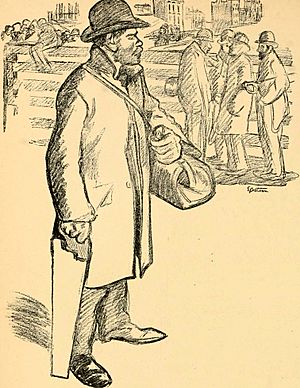
Epstein was born at 102 Hester Street on the Lower East Side of New York City. His parents were Max Epstein, formerly Jarogenski or Jarudzinski, and Mary Epstein, née Solomon, both of whom were Orthodox Jews and whose families had emigrated from Augustów in Poland. The family was middle-class, owning a number of businesses and tenements, and Jacob was the third of their eight surviving children.
As a child Epstein suffered from pleurisy and he left school aged thirteen. Between 1893 and 1898 he attended classes at the Art Students League of New York. In 1898 he organised an exhibition at the Hebrew Institute for a group of local Jewish artists and in 1899 opted to stay at Hester Street when his family moved to Madison Avenue, supporting himself working as a tenement inspector and, briefly, as a physical education instructor. He also began selling his drawings and provided illustrations for two articles by the journalist Hutchins Hapgood. Epstein spent the winter of 1899 working as an ice-cutter with his friend Bernard Gussrow at Greenwood Lake in New Jersey.
In 1900, the Hester Street tenement he was living in burnt down and, as well as losing all his sketches and drawings, he became homeless. With the help of the local settlement movement Epstein took a job as a farmhand in Southboro, Massachusetts. Returning to Manhattan in June 1901 he worked in a bronze foundry while taking classes for sculptor's assistants at the Art Students League of New York. Epstein's first major commission was to illustrate Hutchins Hapgood's 1902 book The Spirit of the Ghetto. Epstein used the money from the commission to leave New York City for Paris in September 1902.
Epstein studied at the École des Beaux-Arts from October 1902 until March 1903 and then, from April 1903 to 1904, at the Académie Julian where he was taught by Jean-Paul Laurens. He shared a studio in Montparnasse with Bernard Gussrow and throughout 1904 and 1905 appears to have studied independently in various Paris museums. He regularly visited the Louvre to view its collection of non-European sculpture, studied Indian and Far Eastern art in the Musée Guimet and artworks from China in the Musée Cernuschi.
Epstein visited Rodin in his studio and met Margaret Dunlop, known as Peggy, (1873-1947) who encouraged him to visit London, which he did in 1904. There he spent some time viewing sculptures from African and Polynesian cultures in the British Museum, all of which were to have a profound influence on his future work.
Career
Throughout 1907 and 1908, Epstein created eighteen large sculptures for the second-floor façade of Charles Holden's new building for the British Medical Association, BMA, on The Strand (now Zimbabwe House) in central London. Epstein created models of each figure in his studio and these were then cast in plaster. The plaster models were taken to the Strand where they were copied in stone by a firm of commercial architectural carvers, John Drymond of Westminster Bridge Road. Epstein then made minor adjustments and changes to the stone figures. This process of using models, casts and commercial carvers was the norm for architectural sculpture at the time and was one Epstein soon came to reject.
In art-historical terms, the Strand sculptures represented Epstein's first thoroughgoing attempt to break away from traditional European iconography in favour of elements derived from classical India sculpture. The female figures in particular incorporated the posture and hand gestures of Buddhist, Jain and Hindu art from the subcontinent.
The Tomb of Oscar Wilde
Near the end of 1908, without any prior discussion or advance warning, Robbie Ross announced that Epstein was the chosen sculptor for a new tomb of Oscar Wilde in the Père Lachaise Cemetery, Paris. After a period spent studying Wilde's writings, Epstein designed a monument featuring a large statue of Narcissus. After several months, he changed his mind and destroyed that, almost-complete, monument in favour of a new design carved directly in stone.lpture.
The design was clearly influenced by the massive Assyrian sculptures Epstein knew from the British Museum and featured, in his words "a vast, winged figure ... the conception of poet as messenger" with smaller figures representing Fame, Intellectual Pride and Luxury. In June 1912, Epstein had the completed tomb displayed in his London studio for public viewing. The work received positive reviews and was highly praised in the British press, including by publications that had been critical of the Strand statues.
Following an introduction from Augustus John in 1910, John Quinn, a wealthy American collector and patron to the modernists, visited Epstein's studio to view the Wilde tomb and quickly became the artist's major patron and collector of his work. After his death in 1924, several of Quinn's Epsteins were acquired by public collections in the United States.
1930s
Without any commissions for large public monuments throughout the 1930s, Epstein worked on a number of large sculptures on religious subjects of personal significance to him, while supporting himself and his family with commissions for portrait busts and by selling paintings of flowers and landscapes.
In 1929, Epstein carved Genesis, a massive, marble, three-ton figure of a pregnant women with a swollen belly and a face based on an African mask. When shown as part of Epstein's February 1930 exhibition at the Leicester Galleries, the response to Genesis was vicious, not just from the popular press but from more serious journals. Epstein took particular exception to an insulting review by the artist Paul Nash. After a break of almost twenty years, Epstein returned to the sculpture Sun God and began, in 1932, to carve a new relief on the rear side of the block, a hunched male figure with two infant forms across his body, titled Primeval Gods.
Epstein spent the summer of 1933 at his cottage in Epping Forest and, in the space of two months, painted over a hundred landscapes and flower compositions. These were shown at Tooth's Gallery that Christmas and his Christmas exhibition of paintings became a popular annual event. During September 1933, on his way to America, Albert Einstein spent some weeks at Roughton Heath, Norfolk, and agreed to sit for Epstein over seven days. Epstein remembered his meeting with Einstein as, "His glance contained a mixture of the humane, the humorous and the profound. This was a combination which delighted me. He resembled the ageing Rembrandt."
Bronze portrait sculpture formed one of Epstein's staple products, and perhaps the best known. These sculptures were often executed with roughly textured surfaces, expressively manipulating small surface planes and facial details.
His larger sculptures were his most expressive and experimental, but also his most vulnerable.
Later years
After the Second World War there was a notable change in attitudes to Epstein and, nearing seventy, he was about to enjoy a sustained period of recognition and one of the busiest periods of his artistic life. Early in 1950, he received his first commission in twenty years for a public monument, the statue Youth Advancing, for the 1951 Festival of Britain. Epstein's 1947 carving of Lazarus was bought by New College, Oxford and installed in the chapel there in January 1952.
In 1947, the architect Louis Osman was employed by the nuns of the Convent of the Holy Child to rebuild their bomb-damaged buildings on Cavendish Square in central London. Osman's design featured a bridge that linked two parts of the complex and would support a large sculpture. The nuns were keen to have a sculpture of the Madonna and Child and planned to employ a Catholic sculptor for the work. Osman was determined to have a work by Epstein and, without consulting the nuns, had him produce a maquette. When the convent rejected Epstein's design on cost grounds, he and Osman, with help from Kenneth Clark and the Arts Council, agreed to cover the cost themselves. The convent agreed to Epstein's design provided he would listen any suggestions they made. After Epstein accepted their concerns about the face of the Madonna and changed the head, from one based on Kathleen Garman to one modelled on her friend Marcella Bazrtti, the convent began working hard to raise funds for the sculpture to be cast in lead. Unveiled on 14 May 1953 by Rab Butler, the Chancellor of the Exchequer, the Cavendish Square Madonna and Child met with near universal praise.
While working on Madonna and Child during 1951 and 1952, Epstein undertook other major projects. In August 1951 he travelled to the United States to view the site in Fairmount Park, Philadelphia where the Philadelphia Museum of Art had commissioned him to create a large sculpture group, Social Consciousness; he was one of 250 sculptors who exhibited in the 3rd Sculpture International held there in the summer of 1949. In London, the Tate hosted a large retrospective exhibition of his work in September 1952 with fifty-nine sculptures and twenty drawings.
Final works
The success of Madonna and Child in 1953 led to a dramatic reappraisal of Epstein's work in general and to more public commissions. That year he received commissions from Llandaff Cathedral and, from the British Government, a commission for a statue of Field Marshall Jan Smuts to be placed in Parliament Square. Such was the scale and quantity of work Epstein took on, he was given the use of an extra large studio in the Royal College of Art. There he worked on the three large figure groups comprising Social Consciousness during 1953, the Liverpool Resurgent figure and parts of the giant Christ in Majesty for Llandaff Cathedral in Cardiff. The cathedral had originally commissioned the figure to be made in gilded plaster but, after Epstein offered to pay for it to be cast in metal, the church authorities agreed to cover the cost of an aluminium casting. It was not until April 1957, that Christ in Majesty, was unveiled, suspended above the nave of the cathedral on a concrete arch designed by George Pace.
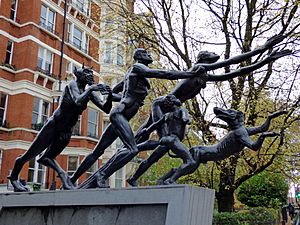
Epstein was appointed an Knight Commander of the Order of the British Empire in the 1954 New Year Honours. Epstein strongly suspected that Winston Churchill had nominated him for the honour. In 1955, he received a request from Basil Spence, the architect building the new Coventry Cathedral, to produce a small maquette for a giant sculpture of St Michael's Victory over the Devil; he also received a commission from the Trade Union Congress, TUC, for a war memorial for their new headquarters building. The following year, Westminster Abbey commissioned a memorial to William Blake for Poet's Corner. As soon as he finished the maquette for Coventry Cathedral, Epstein began making the head and wings of the full-size figure without waiting for the cathedral authorities to approve the project. When reports of the work appeared in the press, Spence made it clear to Epstein that the cathedral was under no obligation to accept it. Epstein said he would do it for his own benefit. When the bishop and cathedral officials visited Epstein's studio to view the work they were greatly impressed and quickly approved the contract for the work. In a 1956 letter to a friend, Epstein wrote that he was "inundated with requests for work on buildings, large works which I don't know I will ever be able to accomplish. I was for so long without any commissions, I don't feel like turning down anything that comes my way, but it is all coming too late I'm afraid."
During 1958, Epstein was too ill to attend the unveiling of the war memorial he had carved at the centre of the TUC Headquarters in London, being in hospital with pleurisy and a thrombosis. While the TUC leadership made no secret of their hatred of the carving, several Labour MPs were greatly impressed and the critic Terence Mulally praised it as "a tragic monument on a grand scale." After spending time convalescing in Italy and France, Epstein resumed working, creating a portrait sculpture of Princess Margaret and starting work on the large Bowater House Group sculpture. Epstein's final works included a posthumous portrait of David Lloyd George for the Houses of Parliament and the Bowater House Group which he completed on the day he died in August 1959.
Personal life
Despite being married to and continuing to live with Margaret, Epstein had a number of relationships with other women that brought him his five children: Peggy Jean (1918–2010), Theo (1924–1954), Kathleen (1926–2011), Esther (1929–1954) and Jackie (1934–2009).
Margaret Epstein died in 1947 and he married Kathleen Garman in 1955. Their eldest daughter, also named Kathleen but known as "Kitty", married painter Lucian Freud in 1948 and was mother of his daughters Annie and Annabel. She is the subject of the painting Portrait of Kitty. In 1953 they divorced. She married a second time in 1955, to economist Wynne Godley. They have one daughter.
Death and legacy
Epstein died in August 1959 at his Hyde Park Gate home and was interred in Putney Vale Cemetery on 24 August 1959 with a service conducted by Dr Hewlett Johnson, Dean of Canterbury.
Epstein's art is to be found all over the world. Highly original for its time, it substantially influenced the younger generation of sculptors such as Henry Moore and Barbara Hepworth. According to June Rose's biography, during the early 1920s Moore visited Epstein in his studio and was befriended by the older sculptor. Epstein, Moore, and Hepworth all expressed deep fascination with non-western art in the British Museum.
Selected major pieces
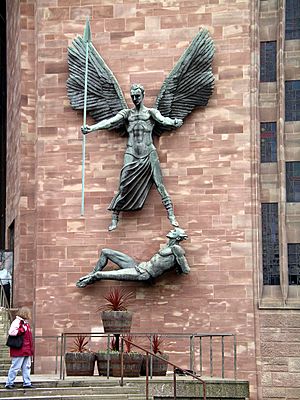
For a more complete list, see List of sculptures by Jacob Epstein
- 1907–08 Ages of Man, British Medical Association headquarters, Strand, London – mutilated / destroyed 1937
- 1910 Rom, limestone, Portrait of Romily John, National Museum Cardiff, Cardiff
- 1911–12 Oscar Wilde's tomb – Père Lachaise Cemetery, Paris
- 1913–14 Rock Drill, bronze — the Tate Collection (symbolising 'the terrible Frankenstein's monster we have made ourselves into')
- 1917 Venus marble – Yale University Art Gallery, New Haven, Connecticut
- 1919 Christ Bronze – Wheathampstead, England
- 1921 Bust of Jacob Kramer - Leeds Art Gallery,
- 1922–30 Head of Hans Kindler - Kemper Art Museum, St. Louis, MO
- 1924–25 W. H. Hudson Memorial, Rima, Hyde Park, London
- 1926 Bronze bust of Ramsay MacDonald, Palace of Westminster, London
- 1927 Madonna and Child, seated bronze, donated to the Riverside Church, New York City in 1960
- 1928–29 Night and Day Portland Stone – 55 Broadway, St. James', London
- 1933 Head of Albert Einstein Bronze – numerous casts
- 1939 Adam Alabaster – Harewood House, near Leeds
- 1940–41 Jacob and the Angel Alabaster - Tate Britain
- 1944– 45 Lucifer - Bronze - Birmingham Museum and Art Gallery
- 1947–48 Lazarus Hoptonwood Stone – Chapel of New College, Oxford
- 1950 Madonna and Child Lead, Convent of the Holy Child Jesus, London
- 1954 Social Consciousness – University of Pennsylvania, Philadelphia
- 1954–55 Christ in Majesty – 5.5m aluminium figure – Llandaff Cathedral, Cardiff
- 1956 Liverpool Resurgent – Lewis's Building, Liverpool
- 1956 Statue of Field Marshall,Jan Smuts - Bronze - Parliament Square. London
- 1957 Bust of William Blake, Westminster Abbey, London
- 1958 Trade Union Victims of Two World Wars - The Spirit of Trade Unionism - Stone - Congress House, London
- 1958 St Michael's Victory over the Devil Bronze – Coventry Cathedral
- 1959 The Rush of Green (also known as Pan or The Bowater House Group), Hyde Park, London
- After 1959 Christ in Majesty – Gilded plaster – Riverside Church, New York City
Images for kids
-
Jacob Epstein self-portrait, ca. 1912, National Portrait Gallery, London
-
Jacob Epstein, by William Orpen, 1927
-
Jacob Epstein in 1934, photograph by Carl Van Vechten
-
Oscar Wilde's tomb, 1912, Père Lachaise Cemetery, Paris
-
The Visitation, 1926, Queensland Art Gallery
-
Day and Night, Portland stone, 1928, London Electric Railway headquarters, 55 Broadway
-
The Archangel Lucifer, 1944–45, round gallery of Birmingham Museum & Art Gallery
-
Edward Sydney Woods, 1958, Lichfield Cathedral
See also
 In Spanish: Jacob Epstein para niños
In Spanish: Jacob Epstein para niños


